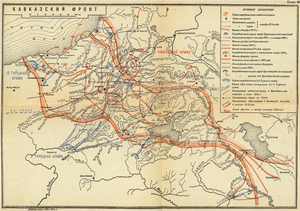Battle of Muş
 From Wikipedia - Reading time: 7 min
From Wikipedia - Reading time: 7 min
This article possibly contains original research. (November 2023) |
This article may require copy editing for grammar, style, cohesion, tone, or spelling. (April 2024) |
| Battle of Muş | |||||||||
|---|---|---|---|---|---|---|---|---|---|
| Part of the Caucasus Campaign of World War I | |||||||||
 Map of military operations on the Caucasus campaign in 1914–1916 by Andrei Zayonchkovski | |||||||||
| |||||||||
| Belligerents | |||||||||
|
| |||||||||
| Commanders and leaders | |||||||||
|
|
| ||||||||
| Units involved | |||||||||
|
Second Army Kurdish Tribesmen |
Russian Caucasus Army Armenian Fedayi | ||||||||
| Strength | |||||||||
| 81,000[11]–120,000[12] men | 50,000 men | ||||||||
| Casualties and losses | |||||||||
| 56,000[12]–60,000 killed, wounded or captured[13][11] | 20,000 killed, wounded and captured | ||||||||
The Battle of Muş, also known as the Ognot campaign, took place during World War I in the southeastern Anatolian region of the Ottoman Empire (present-day Turkey). One of the commanders involved was Mustafa Kemal, who later became known as Atatürk, the founder of the Republic of Turkey.[14] The battle resulted in a Russian victory. After extended fighting, the Russians captured the city of Muş[15] and inflicted heavy casualties on the Ottoman Second Army, nearly destroying it.[3]
Battle
[edit]The Ottomans faced significant setbacks following major Russian victories in the northern theater and the capture of Bitlis in the south. This forced them to redeploy troops, including veterans from the successful defense of Gallipoli against Russia's Western allies.
On 3 August, with a significant manpower advantage (2.5:1), the Turks launched a general offensive along the entire front. After fierce fighting, the Russians abandoned Mus on 6–8 August. Despite heavy pressure, the 1st Russian Division managed to decisively defeat four Ottoman divisions. Due to the remote location, the initial phase of the operation presented logistical challenges for the Russians, who in some areas faced opponents outnumbering them 3–4 to 1.[16]
Through a combination of heroic resistance and the effective deployment of new mobile artillery, the Russians inflicted significant casualties on the Ottomans.[17] Seizing the opportunity, General Yudnich launched a counteroffensive across the entire front.[18]
The Russians recaptured Muş on 23 August, with Ottoman General Faik Pasha reportedly killed during the battle.[3] Some sources place his death on 24 or 25 August.
Aftermath
[edit]A Turkish defeat in the south solidified Russia's military dominance. In the aftermath, the second army suffered heavy losses at the hands of Russian artillery, reducing it to the size of a corps.[3]
References
[edit]- ^ Kreiser, Klaus (2014). Atatürk: eine Biographie (in German). Beck. ISBN 978-3-406-66594-3.
- ^ Jaques 2006.
- ^ a b c d Oleynikov 2016, p. 177.
- ^ Gerald 1992, p. 268.
- ^ Tucker 2002, pp. 180–181.
- ^ The International Military Digest Annual: A Review of the Current Literature of Military Science for 1915. New York City: The International Military Digest. 1916. p. 224. "Noteworthy in this theater is the Russian success in recapturing Mush and Bitlis (Aug 25), which the Turks had won earlier in the month."
- ^ Zayonchkovski 2002, p. 583.
- ^ Reynolds 2011, p. 136.
- ^ Kernosovsky 1938, pp. 554–555.
- ^ Monnier, Fabrice (9 April 2015). Atatürk. La naissance de la Turquie moderne: Naissance de la turquie moderne (in French). CNRS Editions. ISBN 978-2-271-08615-0.
Le 2 août, le 16e corps de Mustafa Kemal, appuyé par des irréguliers kurdes, attaque à nouveau Muş et Bitlis. Menacé d'encerclement, le général russe Tovmas Nazarbekov évacue Bitlis le 5 août puis, quelques jours plus tard, Muş.
- ^ a b Oleynikov 2016, p. 259.
- ^ a b Kernosovsky 1938, p. 554.
- ^ Алексей Олейников. Огнотская операция Кавказской армии — триумф русской гаубичной артиллерии, июль-август 1916 г.
- ^ Erickson, Edward J. (20 August 2013). Mustafa Kemal Atatürk. Bloomsbury Publishing. ISBN 978-1-4728-0458-7.
- ^ Encyclopedia Americana. Vol. 29. Danbury, Connecticut: Grolier. 2000. p. 300. ISBN 0-7172-0133-3. In any case, Yudenich was able to recapture Muş and Bitlis on August 24
- ^ Алексей Олейников. Огнотская операция Кавказской армии — триумф русской гаубичной артиллерии, июль-август 1916 г. // Битва гвардий. Дата обращения: 6 августа 2020
- ^ Allen W. E. D., Muratoff P. P. Caucasian Battlefields: A History of the Wars on the Turco-Caucasian Border. 1828—1921 (англ.). — Cambridge: CUP, 1953. — 614 p. — ISBN 978-1-108-01335-2.
- ^ Айрапетов О. Р. Участие Российской империи в Первой мировой войне (1914—1917): Серия из 4 книг. — М.: Кучково поле, 2014—2016
Notes
[edit]Literature
[edit]- Tucker, Spencer (2002). The Great War 1914-1918. UCL Press. ISBN 1-85728-390-2.
- Reynolds, Michel (2011). Shattering empires : the clash and collapse of the Ottoman and Russian empires, 1908-1918. Cambridge university press. ISBN 978-0-521-19553-9.
- Kernosovsky, Anton (1938). "Борьба на Кавказе" [Struggle in Caucasus]. История русской армии [History of the Russian army].
- Oleynikov, Alexei (2016). Россия-щит Антанты [Russia-Shield of Entente]. Foreword by Nikolai Starikov. St.Petersburg: Piter. ISBN 978-5-496-01795-4.
- Allen W. E. D., Muratoff P. P. Caucasian Battlefields: A History of the Wars on the Turco-Caucasian Border. 1828—1921 (англ.). — Cambridge: CUP, 1953. — 614 p. — ISBN 978-1-108-01335-2
- Zayonchkovski, Andrey (2002) [1929]. Первая Мировая Война [The First World War]. St.Petersburg: Poligon. ISBN 5-89173-174-6.
- Jaques, Tony (2006). Dictionary of Battles. Volume 1; "While Russian General Nikolai Yudenich seized Erzincan, Ahmet Izzet Pasha's Second Army advanced against the Russian left flank, where his corps cammder Mustafa Kemal seized Bitlis and Muş. Yudenich counter-attacked and, after prolonged combat west of Lake Van, he retook Bitlis and the Turks abandoned Muş before winter ended the fighting". Greenwood Press.
- Gerald, Herman (1992). The Pivotal Conflict: A Comprehensive Chronology of the First World War, 1914-1919. Westport: Greenwood Press. ISBN 0-313-22793-4.
 KSF
KSF